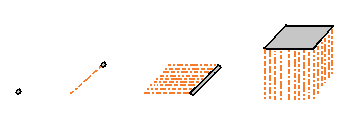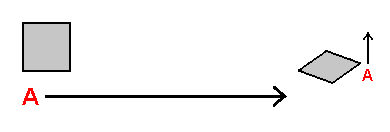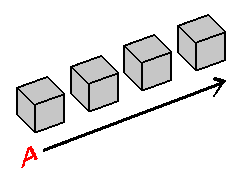
 |
Think back to nearly the beginning of Visualizing 4-space, to the diagram that introduced the concept of "gliding" - perhaps the most-used technique for introducing the concept of spatial dimensions ever made. Structures are moved at right angles to themselves and in doing so, a "trail" is left behind. And it is indeed this very 'trail' itself that 'becomes' the new structure and makes possible the formation of higher-dimensional structures. Once a cube is reached, however, a problem appears - in that there seems to be no way that a cube can move / 'glide' in a direction perpendicular to itself. There was then a message stating that this 'issue' would be addressed later in the material. Now is that time: given the knowledge that we now have, 'gliding' the cube is now possible. As stated, the result of the gliding of the cube would be a 4-dimensional structure known as the hypercube (a 4-dimensional cube). It can be considered to be a 4-dimensional structure in that it exists simultaneously across multiple 3-planes.
The first step in approaching the 'gliding' of the cube is awareness that in a linear array (the type of array we are familiar with), a structure on a plane of empty space has 2 directions of travel to choose from in which to perform its "glide" - direction 'A' and direction 'B' - directions that extend perpendicular to each and every plane of the array and to the structure itself. Either direction will do. However, in order for all upcoming material to move as smoothly as possible and to avoid confusion, all future gliding will be done in direction 'A'. Put this into consideration. The next step in approaching the 'gliding' of the cube is awareness of how the upcoming diagrams operate: for the sake of study, the area across which a given structure "glides" and leaves behind a 'trail' will not be presented as a 'single, unbroken unit' of empty space (which is how the diagram shown above operates). The area across which a structure "glides", rather, will be presented in the form of an array of lined-up 'lesser units' of empty space - through which the structure gliding will 'increment' one plane at a time. To gain a better understanding of this use of 'stacks' / 'arrays' in the gliding process, compare the diagram shown above to the diagram directly below. This use of the concept of 'gliding', managed plane-by-plane in the form of a 'stack' of lesser units, will as of now be known as "stack-gliding".
 |
 | |
 | |
A first demonstration of the concept of 'stack-gliding' can be observed in the diagrams presented to the left. As you can see, a square area of empty space (or '2-space') is required to 'glide' a segment. The first diagram presents a square before being 'stack-glided' - the segment is in its 'initial' position and has yet to 'stack-glide' and leave a 'trail' behind. This situation is represented on the left side of the diagram in the form of a stack-diagram - a Linelander's conception of the situation. To the right of the stack-diagram is a representation of the situation as it occurs in physical reality. Let us begin with a stack-glide of the square. Empty 1-planes lie A-ward. When the segment leaves a plane, it 'leaves behind' a segment equal to itself in that 1-plane, and moves forward into the next 1-plane A-ward. This continues until the square's formation is complete - as is the case in the next diagram displayed to the left. The segment's 'stack-glide' takes place across several 1-planes - and the segment, in the course of its journey, covers a 2-dimensional distance.
 |
 |
The diagrams presented to the right further demonstrate the concept of 'stack-gliding'. As you can see, a cubic volume of empty space (or '3-space') is required to 'glide' a square. The first diagram presents a cube before being stack-glided - the square is in its 'initial' position and has yet to 'stack-glide' and leave a 'trail' behind. This situation is represented on the left side of the diagram in the form of a stack-diagram - a Flatlander's conception of the situation. To the right of the stack-diagram is a representation of the situation as it occurs in physical reality. Empty 2-planes lie A-ward. When the square leaves a plane, it leaves behind a square equal to itself in that 2-plane, and moves forward into the next 2-plane A-ward. This continues until the cube's formation is complete - as is the case in the next diagram diisplayed to the right. The square's 'stack-glide' takes place across several 2-planes - and the square, in the course of its journey, covers a 3-dimensional distance.
 | |
 | |
Before us now lies the challenge to move a cube in a direction perpendicular to itself - to 'glide' the cube. How does one go about doing this? In a manner of speaking, a 'hypercubic hypervolume' of empty space (or '4-space') is required to 'glide' a cube. We begin by placing the cube in its 'initial' position - your room (a 3-plane in the middle of an array of 3-planes) - up above the floor. All of the 3-planes A-ward - (supposedly occupying the "same space" as your own 3-plane) - are empty. The cube has yet to 'stack-glide' and leave a 'trail' behind. The top illustration to the left represents this situation in stack-diagram form - to prepare us for a 'glide' that will take place across several 3-planes. To 'stack-glide' the cube, we simply move it A-ward one 3-plane (into a plane supposedly occupying the "same space" as the original plane, as expressed by the means of reason by which we experience our dimension). In the process of transferring into this new plane, the cube leaves behind a 'trail' in the form of a cube equal to itself, in the plane it previously occupied. As the gliding cube grows farther from its original plane, it is to be considered to become more 4-dimensionally distant from that original plane. If desired, imagine the cubes left behind by the stack-gliding cube to become increasingly smaller as stack-gliding occurs, in the same way that perspective decreases the perceived size of the inner cube of a tesseract. This continues until the final 3-plane is reached. The result of this completed process is a structure known as the hypercube - and is represented to the left in stack-diagram form. The cube's stack-glide takes place across several 3-planes - and the cube, in the course of its journey, covers a 4-dimensional distance. In the next section we make an effort to gain a basic understanding of the hypercube, its structure, and its properties.
| to previous section |
to table of contents |
to next section |
||
| Comments, questions, feedback: [email protected] |